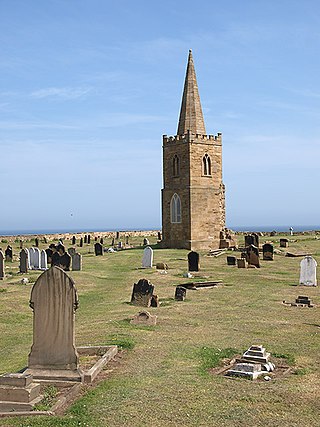Related Research Articles

Lawrence Dundas, 1st Earl of Zetland was a Scottish politician and peer who sat in the British House of Commons from 1790 to 1820 when he was raised to the peerage of the United Kingdom.

Matthew Hutton (1529–1606) was archbishop of York from 1595 to 1606.

Marske-by-the-Sea is a village in the unitary authority of Redcar and Cleveland and the ceremonial county of North Yorkshire, England. It is located on the coast, between the seaside resorts of Redcar and Saltburn-by-the-Sea, although it is not itself a seaside resort. Marske is in the civil parish of Saltburn, Marske and New Marske and comprises the wards of Longbeck and St Germains.

John Woodward was an English naturalist, antiquarian and geologist, and founder by bequest of the Woodwardian Professorship of Geology at the University of Cambridge. Though a leading supporter of observation and experiment in what we now call science, few of his theories have survived.

Matthew Hutton was a high churchman in the Church of England, serving as Archbishop of York (1747–1757) and Archbishop of Canterbury (1757–1758).
Marske is a village and civil parish in the Richmondshire district of North Yorkshire, England, situated in lower Swaledale on the boundary of the Yorkshire Dales National Park, the village is approximately 5 miles (8 km) west of Richmond. According to the UK 2011 Census, the population of the parish of Marske, including New Forest was 127. The parish includes the hamlets of Applegarth, Clints, Feldom and Skelton.
A warren is a network of wild rodent or lagomorph, typically rabbit burrows. Domestic warrens are artificial, enclosed establishment of animal husbandry dedicated to the raising of rabbits for meat and fur. The term evolved from the medieval Anglo-Norman concept of free warren, which had been, essentially, the equivalent of a hunting license for a given woodland.
Sir Conyers Darcy or Darcey,, of Aske, near Richmond, Yorkshire, was a British Army officer, courtier and Whig politician who sat in the House of Commons between 1707 and 1758.

Hutton Conyers is a village and civil parish in the Harrogate district of North Yorkshire, England. It is situated near the River Ure and 1-mile (1.6 km) north-east of Ripon. The parish extends from the River Ure to the A1(M) motorway, and includes the village of Nunwick.

Robert Darcy, 3rd Earl of Holderness, was a British peer and politician.

Sir William Pennyman was an English landowner, soldier and politician.
Robin of Redesdale, sometimes called "Robin Mend-All", was the leader of an insurrection against Edward IV of England. His true identity is unknown, but is thought to have been either Sir John Conyers, steward of Middleham, his brother Sir William Conyers of Marske, or both; the two were long-serving retainers of Richard Neville, Earl of Warwick. Graham Evans lists a number of other possibilities such as Sir John Conyers, the father of the previous Sir John and Sir William; Sir Richard Welles, who married Baroness Willoughby de Eresby; her son, Sir Robert Welles, 8th Baron Willoughby de Eresby; or Lord Robert Ogle, Warden of the East March and Lord of Redesdale.
John Conyers was an English apothecary and pioneering archaeologist. He was known "to collect such Antiquities as were daily found in and about London."

The Gray's Inn Lane Hand Axe is a pointed flint hand axe, found buried in gravel under Gray's Inn Lane, London, England, by pioneering archaeologist John Conyers in 1679, and now in the British Museum. The hand axe is a fine example from about 350,000 years ago, in the Lower Paleolithic period, but its main significance lies in the role it and the circumstances of its excavation played in the emerging understanding of early human history.
James Tunstall (1708?–1762) was an English cleric and classics scholar.
Conyers Read was an American historian who specialized in the History of England in the 15th and 16th centuries. A professor of history at the universities of Chicago and Pennsylvania, he was president of the American Historical Association for the year 1949–1950.
The Venerable Henry Walker Yeoman was Archdeacon of Cleveland from 1882 until his death.

St Germain's Churchyard is a large cemetery overlooking the North Sea at Marske-by-the-Sea, North Yorkshire, England. Its church tower is a grade II listed structure at the midpoint to the yard and a landmark for sailors out on the sea. It is a remnant of a demolished church, services at St Germain's were replaced in 1876 by St Mark's.

Marske Aerodrome was a First World War-era airfield used by the Royal Flying Corps, and later by the Royal Air Force, between 1917 and 1920. The aerodrome was just to the west of the village of Marske-by-the-Sea in Yorkshire, England. Marske aerodrome hosted air gunnery schools and trained pilots in tactics and methods of aerial combat so that they could be deployed to the front. Marske is known for being the aerodrome where W. E. Johns, author of the Biggles books, undertook his training, as well as being noted for some of the flying instructors who were famous among the aircrew cadre.
Hugh Dacre, DCL was Archdeacon of Carlisle from 1509 until his death in 1510.
References
- ↑ Jones, B. (1963), Fasti Ecclesiae Anglicanae 1300–1541, vol. 6, pp. 101–103
- ↑ "Catalogue of the Lansdowne Manuscripts in the British Museum" London, British Museum, 1819
- ↑ "West, Lewis (CNRS495C)". A Cambridge Alumni Database. University of Cambridge.